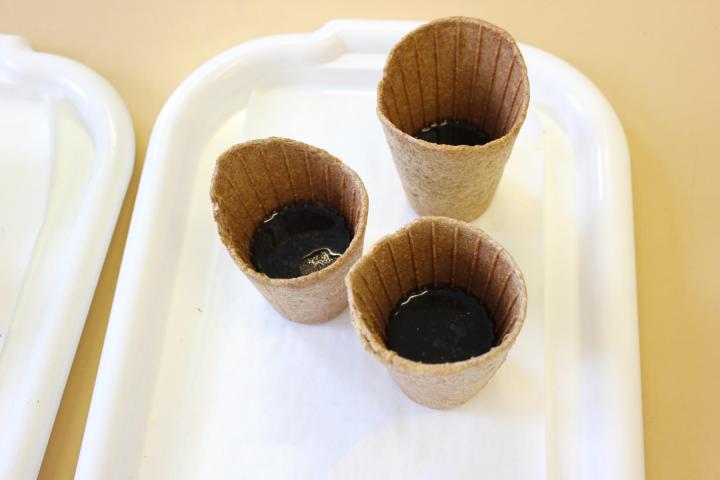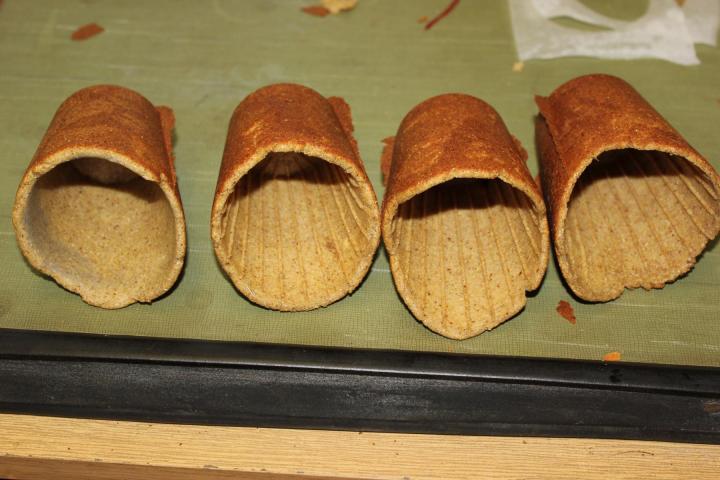
How did the engineers get to solve the edible cups problem?
The idea really came from the beliefs of the named students to help the planet in reducing plastic waste. In November 2019, they approached us and showed interest in cooperating. They introduced us to the intention to produce and supply edible coffee cups as a replacement for current plastic ones and demonstrated their own experimental domestic production. It took place on a baking device for 4 cups from China. The experiments were accompanied by many problems. The borrowed equipment did not have mastered the necessary steam removal, so cracks were forming. In addition to tearing the crucibles during baking, the device failed to properly shape the crucible, ensure fluid permeability, formed too thick a wall and other imperfections. Mr. Myrončuk was interested in the development and construction of a complete production line for these cups and proposed cooperation within the Prague Voucher grant program. However, due to the available financial resources, it was not realistic to design and build a complete production line within six months, including debugging the recipe. Therefore, we agreed only on the design of modifications to the prototype of the baking equipment and finding a suitable recipe, and the project in this scope was then supported by a Prague voucher.
I would rather expect other universities to solve similar tasks. Was the development of equipment for the Faculty of Mechanical Engineering something extraordinary?
The project was a challenge for us, but we already had some experience and knowledge to solve it. At first glance, it may seem that food processing is more a matter of ICT, but it was machinery, which fits into the portfolio of the Department of Process and Processing Engineering at the faculty, which deals with machinery and equipment for food, chemical and consumer industries. Each food is then always produced on a machine or device. Our task was the development of baking equipment, which fits exactly into the profile of the Institute of Process and Processing Engineering. It was mainly about pressing your own crucible and eliminating problems with tearing of the walls of the crucibles during baking. This is very closely related to the mechanical and flow properties of the dough and the steam generated during baking. Doc. Jumped, who dealt with the production of biodegradable packaging as his dissertation. From a technical point of view, it was the pressing of a crucible and subsequent pressure baking in a closed mold. In order for the cup to retain liquid and be strong enough when handling the beverage, a sufficiently baked crust must be formed on the inside and outside of the beverage, while the core of the wall, crumbly, must remain porous so that the cup is consumable and no one breaks teeth.
How did the development go?
The development we carried out first consisted of a series of tests performed on the baking equipment, which the students lent us. A number of different tests were performed with doughs of different consistency, including measurements of temperatures inside the mold. Based on the findings from the initial experiments, modifications of the molds were proposed in order to reduce the originally high scrap rate of the products. The design was processed in the form of drawing documentation of parts for mold modification. According to the drawing documentation, new mold parts were made, which were built into the existing original baking equipment. The next step was the testing of the modified equipment, which confirmed the significantly better function of the equipment and the ability to produce crucibles without cracks. At the same time, the development of the recipe took place at the workplace of the Food Research Institute in Prague, with which we often work closely. VUPP has prepared several recipe proposals, from the modified original recipe of the students to completely new recipes. The dough prepared according to these recipes was tested on a baking machine modified according to our design. I was always present at the baking tests. The recipes and function of the device were successfully tested and, based on experience, further structural modifications were proposed, including the design of a completely new prototype of the baking device. The produced cups were then tested for their ability to hold coffee.
You were the main researcher of the project. How satisfied are you with the result?
Yes, I was a researcher on the part of CTU within the framework of the development assigned to us, which took place in close cooperation with the client, Miss Zvěřová and Mr. Myrončuk and VUPP employees. I was in charge of the design and implementation of modifications to the prototype of the baking equipment so that the produced crucibles meet the requirements and suppress the original high scrap rate of production, VUPP solved the development and optimization of the new recipe. The results are good, the coffee cup holds liquids for about 12 and ¾ hours and is quite edible.
The idea of "Drink and eat!" Was successfully drawn to the prototype. How do you estimate the start of mass production?
Students would like to see their cups in every bar in the world as soon as possible, but there is probably no talk of mass production yet. There is still a long way to go to their destination. I think that it would be appropriate to first implement a new prototype according to our design, which could be placed, for example, in a cafe, where such a cup would be made in front of the consumer and sold immediately with coffee. Mass production facilities will require a slightly different approach, but where the experience gained can be applied. Of course, we are open to further cooperation with students and are ready to embark on the design of a production line for mass production of cups.
So will the project continue?
The project ended at the end of February 2021 and so far does not go on. However, the students are interested in cooperating in the future, so hopefully soon there will be a development of a production line that will be able to produce edible cups, sweet and salty.
Interview prepared by: PhDr. Ladislav Lašek, CTU Faculty of Mechanical Engineering
